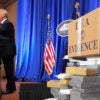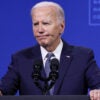During his State of the Union Speech President Obama underscored his goal of “getting to zero” nuclear weapons by citing Ronald Reagan’s aspirations for a world without nuclear weapons:
I have embraced the vision of John F. Kennedy and Ronald Reagan through a strategy that reverses the spread of these weapons, and seeks a world without them.
The Daily Signal depends on the support of readers like you. Donate now
With all due respect, this statement was misleading and disingenuous. Ronald Reagan’s long-term vision of a world without nuclear weapons presupposed a robust missile defense—the Strategic Defense Initiative (SDI)—that would render offensive nuclear weapons directed at the U.S. obsolete. Reagan’s world view was buttressed by confidence in America’s leading role in the world. As such, Reagan always dealt with the Soviet Union from a position of strength. This included a robust nuclear modernization program, including the B-1 and B-2 bombers, filling out the Trident submarine fleet and its Submarine-launched ballistic missile (SLBMs) and the MX or Peacekeeper missile.
The Obama Administration, in contrast, has taken a different approach. Amidst a constant barrage of Russian demands, it canceled the Bush-era European missile defense and has sought to reduce total missile defense funding by $1.62 billion in its FY 2010 Budget Request. In December 2009, the Administration acquiesced to the reduction in missile defense spending—nearly a 15 percent decline from the FY 2009 appropriation of $10.92 billion.)
After the cancellation of the Bush-era missile defense system, both President Dmitri Medvedev and Prime Minister Vladimir Putin pocketed the concessions, smiled, and demanded new ones. Russian president Dmitri Medvedev praised the decision saying, “We appreciate this responsible move by the U.S. president toward realizing our agreement…I am prepared to continue the dialogue.” Prime Minister Putin said that other US concessions should ensue: “I expect that after this correct and brave decision, others will follow…”
The Obama Administration’s haste to “get to zero” LINK has clearly emboldened Moscow in the negotiations over the successor treaty to the 1991 Strategic Arms Reduction Treaty (START). According to the Russian press, Kremlin sources are saying that Moscow feels it has the upper hand in the negotiations because the follow-on treaty is perceived as more important to the U.S. than Russia.
U.S. lawmakers are now particularly concerned about what concessions the Administration may make in the final rounds of negotiations. A primary fear is that the Administration will not submit specific plans for U.S. nuclear modernization as stipulated in the National Defense Authorization Act for Fiscal Year 2010. There are also concerns that it will undermine Prompt Global Strike (PGS) intercontinental ballistic missiles with conventional warheads as well as limit options on U.S. missile defense.
There is yet another key distinction between President Reagan’s approach to arms control and Obama’s. Reagan was clearly willing to walk away from an arms control deal at the summit with Soviet Secretary General Mikhail Gorbachev at Reykjavik, Iceland in the face of Soviet demands to scrap SDI. He was right to do so. He still achieved the 1987 intermediate-range nuclear force (INF) agreement he was seeking and put in place arrangements for the eventual conclusion of the START treaty and the Conventional Forces in Europe (CFE) Treaty. Ronald Reagan’s vision compelled him to walk away from the talks at Reykjavik on the grounds that Moscow’s proposals would make the U.S. more vulnerable. Likewise, the U.S. Senate must ensure that the new treaty is also consistent with Reagan’s principles or refuse to ratify it.































